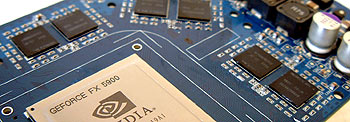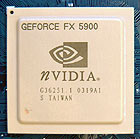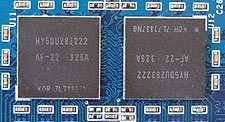 It seems like history has a sense of irony... 3dfx
was finished off by nVIDIA when they missed a product cycle. nVIDIA is not about
to fall into the pages of history so easily though and that's mainly thanks to a
large, and loyal OEM base (a safety net 3dfx never had). On the retail side, things
were quite different though. Even die
hard nVidiots
are switching to ATi in droves.
It seems like history has a sense of irony... 3dfx
was finished off by nVIDIA when they missed a product cycle. nVIDIA is not about
to fall into the pages of history so easily though and that's mainly thanks to a
large, and loyal OEM base (a safety net 3dfx never had). On the retail side, things
were quite different though. Even die
hard nVidiots
are switching to ATi in droves.

Probably the biggest issues
enthusiasts and gamers had with the GeForceFX 5800/5800 Ultra (NV30) are that the
NV30
could only render 4
pixels in one pass in single texture games while ATi's R300/350, or even nVIDIA's
own GeForce4 Ti line of GPU's could render 8 pixels. In multitexture games the NV30
could render 8 pixels.
The
second issue with the NV30 that really irked the hardware
community was the relatively narrow 128bit memory bus between the GPU and
memory. Because of the ability to only render 4 pixels in single texture environments and
the restrictive memory bus, the GeForceFX 5800/5800 Ultra was actually quite
slow. On a side note, because of the higher core clocks (500 MHz for NV30,
450 for NV35), the GeForceFX 5800 Ultra has higher theoretical fill rates
(single and multi textured) then the GeForceFX 5900PV Ultra. However because FX
5800 Ultra is bandwidth limited in reality the FX 5900PV Ultra is
faster.

nVIDIA
did not "fix" the single texture issue as modern
games all take advantage of multi-texturing (older games user single texturing).
They did fix the memory bus however. With the NV35, nVIDIA doubled the
memory bus from 128bit to 256bit and despite having the memory run slower (1 GHz
DDR2 on the NV30, 850 MHz DDR for NV35) the GeForceFX 5900PV Ultra has more
bandwidth (16GB/s vs 27.2 GB/s).
Our buddies at Anandtech have a great write up on
GeForceFX 5900PV/5900PV Ultra technology. If you'd like to learn more about it,
check out their article here. Up next week take a hi-res look at the image
quality differences between the nVidia FX5900 and ATI Radeon 9800!
